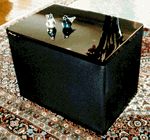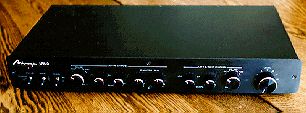Product Review -
Mirage BPSS-210 Subwoofer and
LFX-3 Electronic Crossover - December, 1995
By John E. Johnson, Jr.
![]()
 |
 |
Read on to see an animation example of speaker motion.
Mirage BPSS-210 Subwoofer and LFX-3 Electronic Crossover; Servo-Feedback (accelerometer) Bipolar subwoofer; Two 10" drivers; frequency response 18 Hz - 100 Hz; excursion plus or minus 0.5"; 250 watt rms power amp built into enclosure; Size 18"H x 23"W x 18"D; weight 94 pounds; $1,500; Mirage Loudspeakers, 3641 McNicoll Avenue, Scarborough, Ontario, CANADA M1X 1G5; Phone (416)-321-1800 Fax (416)-321-1500.
Mirage LFX-3 Electronic Crossover; Three channel active crossover; crossover frequencies - 50, 60, 80, 100 Hz; low pass 24 dB/octave; high pass 12 dB/octave; input impedance 100 kOhms; size 2.5"H x 17"W x 9"D; weight 6.4 pounds; $700; Mirage Loudspeakers, 3641 McNicoll Avenue, Scarborough, Ontario, CANADA M1X 1G5; Phone (416)-321-1800 Fax (416)-321-1500.
We all used to think that subwoofer sound is non-directional, that is, we can't tell where it is coming from in the listening room. As a result, summing all the subwoofer frequencies and placing the sub just about anywhere was thought of as being OK. Well, the concept of being non-directional is probably true for the really low stuff - say 30 Hz. But as we begin to approach the upper limits of the typical sub (about 90 Hz), the sound becomes more and more directional. Secondly, summing all the low frequencies into one sub will help the pocketbook, but not the special effects. Phase cancellation can and does occur with out-of-phase multiple frequencies coming into the subwoofer amplifier. With AC-3 having low frequencies in all 5 channels and the LFE (Low Frequency Effects) channel as well, phase cancellation with one sub gets even worse. How do we solve this problem? Well, I am afraid we will have to get more than one sub. The solution can be made less painful by getting them one at a time as the budget allows, and planning ahead. Here is where the Mirage BPSS-210 and LFX-3 come in.
Here's an animation example of how bipolar speaker motion works.
Here's an animation example of how dipolar speaker motion works.
(Note: Your browser must support animated gifs to view this animation.)
In the case of the BPSS-210, the two drivers are mounted on opposite sides of the enclosure (instead of the front and back). Each driver is in a separate sealed enclosure, mounted within the complete enclosure along with the amplifier. The maximum excursion of the drivers (referred to as "x-max" in specification manuals) is 1" peak-to-peak, or in other words, plus or minus 0.5". This is quite a bit of cone movement for a 10" driver, but we are talking about a subwoofer here, and one that is expensive. The cabinetry has black knit material surrounding the front and sides, and a mirror finish piano black lacquered top. The overall appearance is one of elegance. There are no legs for the subwoofer, so it should be placed on a rug.
The BPSS-210, as well as the soon-to-be-available BPS-250, requires an outboard crossover. The LFX-3 fills the bill. It is a three channel crossover (as compared to the LFX-2 which is two channel), stereo for left and right, and mono for use with a center channel. The crossover is fed by the L,C,R (Left, Center, Right) line level signals from the A/V processor. High pass filtered signals from the crossover are fed to the L,C,R power amplifiers. The crossover is capable of driving 1 subwoofer-summed L,C,R low pass; 2 subwoofers-L+1/2C and R+1/2C low pass; or 3 subwoofers-L,C,R low pass. The center channel has selectors for the crossover frequency, the low pass shape, high pass shape (fine tunes the slope), image (blends real and phantom information with the rest of the system speakers and subwoofers), and level (for adjusting center channel level compared to right/left). A second set of selectors controls the left/right subwoofer channels, and has the crossover frequency as well as low pass - high pass shape controls (independent of the center channel controls). A master level control allows setting the subwoofer output for all three channels at once. Besides the on/off/bypass toggle, there is a toggle for 1,2, or 3 subwoofers (sums all three when set to 1), and a 180 degree phase toggle. The LFX-3 has three line level RCA jack inputs (Left, Center, Right), three line level RCA jack outputs for high pass to the amplifiers for speakers which will be handling the mid-range and highs, and three line level RCA jack low pass outputs which can feed up to three separate powered subwoofers. The LFX-3 is powered by a 16 vAC transformer which plugs into the AC outlet, with a cable that plugs into the back of the LFX-3. The back of the BPSS-210 has an RCA line level input jack (to be fed by a coax audio cable from the LFX-3), an on/off button and standby button.
The reason we requested the LFX-3 crossover network, is that, for an ideal setup, whether it is Pro Logic, or AC-3, having separate subs for the sub-out and main front left/right, or for the LFE and main front left/right is going be desirable, but in particular, with AC-3. For a start, we connected the BPSS-210 and LFX-3 in a one sub configuration, because that is what most of us can afford as an initial purchase, with a second and third sub down the line in time.
For our measurements, we used the crossover with the center channel circuit, and all of its controls set to minimum, except for the level, which was set at the straight up position. We turned the main level control up, using sine wave input, until the protection circuitry kicked in (indicating overdrive), and then adjusted the volume down just a hair. We measured the output of the subwoofer with a real time spectrum analyzer/SPL instrument at 1 meter from the right side, and also in the "sweet spot" (about 8 feet in front). The maximum output had to be adjusted a bit at each frequency. At 50 Hz, the maximum output was 101 dB at 1 meter and 101 dB in the sweet spot. At 24 Hz it was 96 dB at 1 meter and 98 dB in the sweet spot, and at 16 Hz the BPSS-210 put out 95 dB at 1 meter and 96 dB in the sweet spot. When our equipment wrangler turned on the 16 Hz, he asked me, "well, what do you think?" I said, "about what?" "The 16 Hz," he responded. I had to look at the SPL meter to see that the sub was indeed operating at 16 Hz. The fact that I could hear nothing (I could vaguely feel it) meant that the harmonic distortion of the BPSS-210 was astonishingly low. Otherwise, if I had heard a tone, it would have been the 2nd harmonic at 32 Hz. Mirage warns users that there will be a tendency to turn it up too loud, because there is such a low distortion spec on this subwoofer. I was surprised at how true this is with the BPSS-210. Not too shabby!
Even with just the one sub, movie sound tracks were terrific. Jurassic Park is a standard test for most people, and, although it was not as loud as with a very good passive radiator sub, it was very deep and very clean (you have to decide what you want from a sub, lots of volume which includes some harmonic distortion, or not so loud, but no distortion). Sound tracks that were a little boomy on the passive radiator sub - leaving us with the feeling of separation of main sound from subwoofer sound - blended seamlessly with the BPSS-210 and main speakers. Music from CDs was great too, with never a hint of boominess regardless of the volume level. In fact, when Jeanne Fairbrook auditioned the Mirage, she felt that there was less "awareness of subwoofer" in the system. The overall sound was, therefore, more unified.
The bipolar sound, in general, extends the soundstage, in our opinion. We found that, even at very low frequencies (such as thunder), there was much less localization to where the sub was situated in the room. At 50 Hz, there was less localization with the BPSS-210 than with the passive radiator sub, or single driver sealed sub, but in our opinion, the bipolar sound is very desirable for helping to eliminate the sensation of listening to sound from a box, and gives more of a feeling of being immersed in the sound field. Thus, we have a particular taste for bipolar and dipolar sound anyway. Dipolar results in a substantial amount of potential phase cancellation between the two sides where the sound exits the enclosure, whereas bipolar has much less. Our conclusion on this is that bipolar subs would be great to have all the way around in a home theater system, and if you prefer more localization of the higher frequencies, then standard driver configurations for the mains. On the other hand, dipolar or bipolar will enhance the sound stage for the mids and highs too, and we use planar/magnetic speakers for just this reason.
In sum, the BPSS-210 and LFX-3 combination represent state-of-the-art in subwoofer design. Deep, deep lows with no audible distortion at full output appears to be the hallmark of the Mirage, and if you are in the market for quality, this is a great place to start looking and listening.
John E. Johnson Jr.
Editor-in-Chief
Other related articles
![]()
© Copyright 1995, 1996, 1997
Secrets of Home Theater & High Fidelity
Return to Table of Contents for this Issue.

